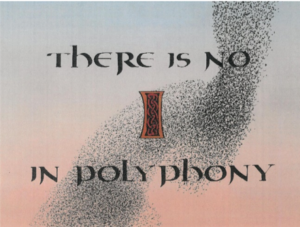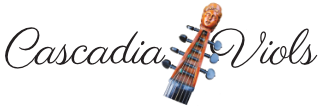17 Dec Vol. IX, No. 4 – October 2023
In this issue:
Cascadia Viols is the quarterly newsletter of the Viola da Gamba Society ~ Cascadia, a chapter of the Viola da Gamba Society of America.
Roma Sprung | President
romasprung@gmail.com
Janet Loy | Secretary
jandayloy@comcast.net
David Solet | Treasurer
dsolet@gmail.com
Board members at large
Robert Clark | Webmaster
rlclark3@gmail.com
Jeanne Collins
traingal2@gmail.com
Dirk Freymuth
dirk@dirkfreymuth.com
Kris Hoeveler
fkhoeveler@gmail.com
Adaiha MacAdam-Somer
adaihascello@gmail.com
Zoe Tokar
zoetabbycatz@gmail.com
Karen Bartlett | Editor
dagamba@ucsbalum.net
Cascadia Viols is grateful to:
St. Michael & All Angels Episcopal Church for hosting our events
Boulder Early Music Shop for the material in our lending library
President's Message
Greetings fellow gambists. Welcome back from summer dreams. With the weather moving slowly to fall my thoughts are turning to our season of workshops.

I am very excited as we are currently finalizing our new season of workshops. As you can see when you look at our website, Josh Lee is coming for our first workshop. By the time you read this, it’s possible he will have been and gone. He was here for a month in the summer on an extended holiday, and some of our folks were able to have some lessons and consort coaching. However, if you miss him, our second workshop will be led by the amazing Mary Springfels, December 16. I am very excited to have her come this year, as it has been a while, and she always brings an amazing energy to a workshop. You can see the rest of our plans later in the newsletter.
I was able to attend Viols West Workshop in San Luis Obispo in August, and, as always, we all had a marvelous time. The setting is lovely and the gathering of lovers of the gamba and faculty is always delightful. I think the highlight of the day might be Princess Lucky’s teahouse run by the inimitable David Morris, who knows that a fine afternoon tea is the perfect antidote to flagging spirits and energy, allowing us to continue our music on into the night. I always wish the week could go on forever, but alas all good things do eventually come to an end, but I left energized by the intensive week of playing and the old and new friends I saw there.
We have a few new members this year, folks who are new to the state. I look forward to meeting them when we have an opportunity to get together.
Enjoy the fall colors. I, for one, am always looking for new ways to enjoy my favorite squash, the mighty pumpkin.
Musically yours,
Roma Sprung
Cascadia Viols Calendar
Our October 7th workshop with Josh Lee may have already taken place by the time you read this (registration for the workshop closed September 30). If you missed Josh’s workshop, you can read about it in the next newsletter appearing in January. Here’s our line up of the coming season’s workshops, with as much information as is presently available. As usual, due to vagaries of the weather, over the winter months our workshops are online. In-person, day-long workshops are held at St. Michael and All Angels Episcopal Church in Portland, OR.
- October 7, 2023 – Josh Lee
- December 16, 2023 – Mary Springfels (see more about Mary below)
- January 13, 2024 – on line, presenter TBA
- February 10, 2024 – on line, presenter TBA
- March 23rd, 2024 – Shanon Zusman
- May 11th, 2024 – Bill Skeen
Mary Springfels
 Many of you already know our esteemed presenter in December, Mary Springfels, a veteran of the American early music movement. In 1968, she became the youngest member of the New York Pro Musica, and has been active in the performance of medieval, Renaissance and baroque music ever since. After a decade of freelancing in New York, she became Musician-in-Residence at Chicago’s Newberry Library, and was the founder and director of the Newberry Consort until 2008. In 2009 Mary moved to New Mexico where she is co-director of Severall Friends, a collection of musicians devoted to the performance of early repertoires in Santa Fe. She is a busy freelancer, appearing regularly with The Texas Early Music Project, Sonoma Bach, LOBO of Sonoma, Ars Lyrica of Houston, Parthenia, and the Folger Consort. She was recently a soloist on the Main Stage of the Berkeley Early Music Festival, as well as performing in the Corona del Mar and Amherst Early Music Festivals. She has taught at the University of Chicago and Northwestern University, and is a regular faculty member at the Summer Toot, SFEMS Early Music Weeks, The Viola da Gamba Society of America Conclaves and Viols West.
Many of you already know our esteemed presenter in December, Mary Springfels, a veteran of the American early music movement. In 1968, she became the youngest member of the New York Pro Musica, and has been active in the performance of medieval, Renaissance and baroque music ever since. After a decade of freelancing in New York, she became Musician-in-Residence at Chicago’s Newberry Library, and was the founder and director of the Newberry Consort until 2008. In 2009 Mary moved to New Mexico where she is co-director of Severall Friends, a collection of musicians devoted to the performance of early repertoires in Santa Fe. She is a busy freelancer, appearing regularly with The Texas Early Music Project, Sonoma Bach, LOBO of Sonoma, Ars Lyrica of Houston, Parthenia, and the Folger Consort. She was recently a soloist on the Main Stage of the Berkeley Early Music Festival, as well as performing in the Corona del Mar and Amherst Early Music Festivals. She has taught at the University of Chicago and Northwestern University, and is a regular faculty member at the Summer Toot, SFEMS Early Music Weeks, The Viola da Gamba Society of America Conclaves and Viols West.
Calendar for a Musical 2024
– Eileen Flory, Lost in Time Press designer
 Lost in Time Press, headed by Newport, Oregon, musician Corlu Collier, is publishing a 2024 calendar to come out later in October. Each month has an image, a line of original music to play, and a musical quotation that will inspire you or make you smile. You can visit www.lostintimepress.com and order yours at any time; the cost is $12 each. They would make good gifts for musical friends. While you’re there, take a look at the 38 other Lost in Time Press music editions, which include some titles for the holiday season. They’re all intended for recorder, but some work just fine on the viol as well.
Lost in Time Press, headed by Newport, Oregon, musician Corlu Collier, is publishing a 2024 calendar to come out later in October. Each month has an image, a line of original music to play, and a musical quotation that will inspire you or make you smile. You can visit www.lostintimepress.com and order yours at any time; the cost is $12 each. They would make good gifts for musical friends. While you’re there, take a look at the 38 other Lost in Time Press music editions, which include some titles for the holiday season. They’re all intended for recorder, but some work just fine on the viol as well.
Tortoise or Hare?
~ Karen Bartlett
A violinist/gambist friend once suggested that I practice violin music on treble to improve my playing, but I was never brave enough to try or committed enough to set aside time to devote to music I thought would be way too difficult for me.
Well, that has now happened, thanks to Dick Yates transcribing Bach’s Trio Sonata BWV 1039 from its original key of G major to F major for our viol consort. Several sources say this sonata is for two transverse flutes and BC, but since the original manuscript is missing, it is uncertain what particular instrumentation, if any, Bach had in mind. Some scholars think an earlier version, a lost manuscript, may have been for two violins. As Dick wrote to me, “Since it is a very standard trio sonata in form, and Bach was certainly aware that those were commonly played with a variety of ensembles, it may not even have been composed for a specific combination, and maybe he even did it keeping in mind the limits and resources of several instruments to enable that varied use.”
But here’s the surprise, for me: the first time I heard this trio sonata, it sounded exceedingly familiar, but I couldn’t figure out why. Then it finally hit me: it is a version of the Viola da Gamba Sonata, BWV 1027! (Incidentally, of the three Bach gamba sonatas, 1027 is the only one that survives as an autograph score.) Below you will find Dick’s transcription of the fourth movement of BWV 1039, so if you only play treble, but love Bach’s sonata for bass, here’s your chance to play the movement as a trio. And if you play bass, here’s your chance to play the continuo line with two treble-playing friends. If you don’t want to have to deal with 6 pages of score, let Dick know (richard@yatesguitar.com), and he will gladly send you separate parts.
For our next consort session I am practicing this fourth movement, an Allegro moderato, and am finding it an excellent and enjoyable musical exercise. (Both top lines are fairly equal, so the second line would work just as well). It may be labeled an allegro moderato, but after listening to YouTube performances, it seems that most people take it at a pretty good clip. I am certainly never going to reach the point of playing it up to their tempo, but no matter; even slowly, it is very satisfying. After all, it’s Bach!
At first glance at the music, knowing my consort wouldn’t be taking it up to tempo, I didn’t think I would have to spend much time on it – just one flat, and mostly a series of short scale passages. How hard can that be unless you are new to the viol? It turns out, I have found that practicing this at a very slow tempo gives me time to pay careful attention to many details, and hear many things in my playing I am not happy with, which at a faster or even moderate tempo would escape my attention. I have always had the habit of practicing pieces slowly, but usually it’s because they were just too difficult to play any faster. In this case, however, I have discovered that practicing even a seemingly straightforward piece very slowly can be very rewarding.
If you’re not used to slow practice, with attention to a lot of detail, it might feel as though it will take forever to learn the piece, but for me, even if I don’t get through the whole movement in one session, what I work on this way sticks better, and in the long run takes less time to learn well. Slow practice focusing on shorter passages also helps me feel more relaxed, which in turn helps me both physically and mentally. This way of practicing may not be for everyone, but if this is a new approach for you, I recommend trying out being a tortoise, even with a simple piece.
Here are some things this movement and the tortoise are teaching me:
- Scales: I confess I’ve never practiced scales much, but with so many frequent scalar passages, it’s hard not to become comfortable with an F major scale, plus a few others thrown in. So if you don’t like practicing scales, here’s a sneaky way to sweeten the medicine. Remember, you’re playing Bach!
- Placement of fingers at the fret: at a slow tempo it is so much easier to hear and evaluate every single note, select those which I don’t like, and then figure out what the problem is (not always easy to do). There can admittedly be multiple reasons, but often I find it is because my finger is not right up against the fret, and most often it is my weak fourth finger which is the culprit.
- Extensions: the key of F offers plenty of opportunity to extend the first finger back (F on the E string, B flat on the A string, and with a key change, E flat on the top string), again making sure that the finger is well placed at the fret. Easier on treble than bass, of course, but even so, my first finger likes to end up more on top of the fret.
- Building concentration: the many extended scalar 8th note passages, though not difficult, can feel like they go on forever, with no rests or longer value notes to break them up, and I find them a good exercise for keeping my attention focused on what I am doing. I also find I need to practice looking ahead at what’s coming (is the line heading up, or down, or sequencing?), especially if I’m trying to up the tempo.
- Straight bow: while I am playing a piece, I find it difficult to use a mirror to check whether my bow is straight; I get lost when I keep switching my gaze from the sheet music to the mirror and back. With this piece, since much of it is scalar, by slowing the tempo down, my brain has time to look back and forth between the music and my bow in the mirror. And then there are those large leaps to check on…
- String crossings: these are very often octave leaps, up to the top string, or occasionally the reverse, so these are great for working on eliminating any extraneous sounds in between the two notes, in addition to using a mirror to see if my bow is remaining straight.
- High A on the top D string: there are several in this movement, and these really use to scare me, because I never could get a good tone. I still find I need to practice hitting that note cleanly in different contexts (here, approaching it in a scalar pattern, or approaching it from an octave below), in order to check my finger placement against the fret, make sure my bow is straight, and decide if bow speed is appropriate. Some apprehension on my part must still linger, since I sometimes find my bow arm has a tendency to tense up on that note—a surefire way to get a shrill sound.
- High B flat on the top string! If you don’t feel challenged with the above, then maybe this will cause a twinge of panic, as it does for me. The first time I noticed it occurring, I breathed a small sigh of relief because it is preceded by a rest. The second time, an open D string is a big help. I remember being grateful when Joanna Blendulf assured me, “It’s not cheating to look!”
- Relaxation: playing something like this at a slow tempo—even just selecting short passages from it—is a great way to free up the brain to pay attention to posture (is my back slumped, again?) and to relaxing muscles that don’t need to be under tension (why are my calves so tight?). I think back to our May 15, 2021 online workshop with Elizabeth Reed, who is a certified practitioner for the Feldenkrais Method of Awareness Through Movement. It’s well worth reviewing her reminders (from the July 2021 newsletter):
When playing viol, she explained that we need to be fully engaged, but with a very balanced position so that no one muscle is being taxed. If we have a strong foundation via awareness of our sit bones, legs, and spine, then it is unlikely we will end up stuck in one position, and we can learn to be aware of the need to make small, even minute adjustments depending on what we are doing and what we are playing. Bowing on the top string, for example, might call for an almost imperceptible (to the observer) rotation of your sit bones (which also affects your spine) to the left. Elisabeth reminded us that the ability to initiate a musical gesture which you can hear in your head always requires a physical gesture. When something is not sounding or working the way you would like, it is important to be aware of what your body is doing. If your arm feels stuck, are you perhaps holding your breath? If your fingers feel restricted, are you squeezing your thumb?


